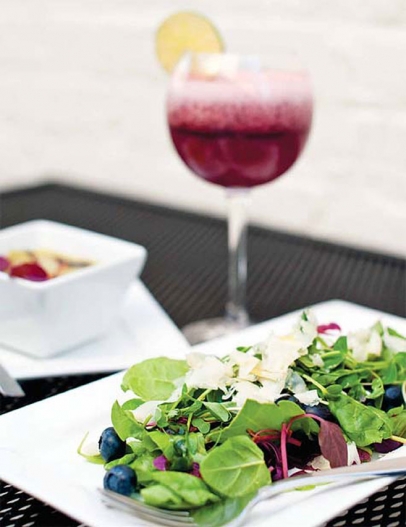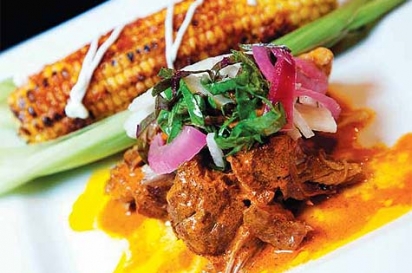Farm(er) to Table
Café puts local farmers on the menu and in the spotlight.
Amanda Fuller sat at a table on the sidewalk near the front door of the Mayan Café. The Louisville restaurant on East Market Street was buzzing with business despite the fact that it was a Monday night. Fuller, who is operations manager for Breaking New Grounds, a small urban farm in Louisville, gave away miniature bags of “Life’s Magic,” a compost.
She also sold large bags of the compost, which is created out of coffee grounds, food waste and leaves and then digested by worms to become a supercharged soil amendment. She also sold bags of fresh greens that the group grows in the compost. “Want to come to our mushroom workshop?” she asked, handing out a flyer for a weekend event.
Clearly the stand in front of the popular restaurant offered a chance to capture an audience, sell some goods and push an upcoming workshop. Mayan Café customers took advantage, evidenced by the bags of purchased items parked at their dining tables. They also tasted dishes made with the Breaking New Grounds’ arugula, radish shoots, pea shoots, greens, Swiss chard and basil.
There was a knock-your-socks-off salad made by combining Breaking New Grounds greens, radish shoots and pea shoots with local blue cheese and blueberries. A chilled soup featured Breaking New Grounds arugula puréed with collard greens to create an appetizer course rich in both taste and color. There were also a juice and entrée using the urban farm’s ingredients.
“I told Amanda I want this to work for them. I want them to get what they need out of this,” Chef Bruce Ucán said. This is the third year for what the restaurant calls Mayan Market Mondays.
Said Anne Shadle, the café’s general manager, “Three years ago we were thinking to close on Monday nights, actually, because they were slower than the other nights we were open.” But in a discussion about “what to do with Mondays,” her sister, Christina Shadle, who is Bruce’s wife and the third member of their business strategy team, suggested doing something with local farms.
The first year of Mayan Market Mondays focused on the food — new specials and local ingredients. The second year the emphasis was on the farmer. Farmers went around and talked to the diners, sharing stories and answering questions.
This year Ucán got the idea to have the farmers set up a stand to sell their products, giving them an even more prominent role in the evening. The first Mayan Market Monday of 2011 was the busiest Monday of all three years combined, Shadle said. Contact with the growers is encouraged by the at-the-front-door stand but also by a question on the menu: “Have you met your farmer tonight?”
Clearly Ucán’s advocacy for local food products is in line with the public’s desire to eat farm-to-table foods.
He said the turning point in shifting to as many local ingredients as possible came in the summer of 2009 when he saw the documentary Food Inc. at his wife’s urging. The film examined agribusiness in America, concluding that corporate farming produces food that is unhealthy and does it in a way that harms the environment, animals and employees.
Ucán — a native of Mexico’s Yucatan peninsula whose mother still cooks on a outdoor stove, pictured in photographs at the restaurant — began his slow, steady move away from mass-produced foods. Since December 1, 2009, the Mayan Café has used only locally produced meats and more and more other local ingredients are a mainstay of the menus. “This has been a gradual transition,” Ucán said.
The café’s June menu listed 11 local farms as regular sources of ingredients. But other farmer markets and urban community gardens are resources for his kitchen as well. He and Shadle went out of their way to select six “all new farms” for the Mayan Market Monday menus, ones that hadn’t been featured during the first two years of the Monday night event.
These are fairly small operations, Shadle said. She sees their selection for showcasing as another way for the restaurant to develop closer relationships with more farms and give them exposure in the Louisville market. Ucán is pleased that the number of farm operations near Louisville is growing, helping to support his needs and those of other restaurants.
But local products cost more than industrial agriculture products. Shadle said the food costs of the café amount to about 25% of overall costs. “They certainly would be less without farm-to-table ingredients,” she said. But Ucán mitigates higher costs several ways. By buying regularly he is able to get about a 10% discount from most growers. He tries not to buy more food than can be used while it is fresh. He buys about 20 pounds of pork at a time for his signature salbutes. That amount of pork lasts about two days.
The restaurant credo is: “If we buy it we use every piece,” Shadle said. Ucán says labor in the kitchen significantly intensified with the use of more local food — more peeling, trimming, scrubbing and other chores that left the kitchen staff grumbling until they got used to the tasks.
He and Shadle wish they could use local lima beans in season for his popular Tok-sel lima beans. “I wish, I wish,” said Shadle, “but we use an insane amount of lima beans and the fresh are so labor intensive. We’d have to hire someone to shuck them and do nothing else.” So they use frozen. Future goals include using local fish and creating more fresh juice drinks.
For the Breaking New Grounds Mayan Market Monday menu, the juice was made of blueberries with basil. Look for more and varied juice drinks this summer.
But don’t expect changes to come with lightning speed. “We want to make sure we can handle a change and do it right when we do it,” Shadle said.
RECIPES
Salbutes with Local Cherry Tomatoes, Basil & Kenny’s Blue Cheese
Cochinita Pibil with Roasted Mexican-style Corn on the Cob
SALBUTES WITH LOCAL CHERRY TOMATOES, BASIL & KENNY’S BLUE CHEESE
The dough recipe makes about 40 salbutes; topping serves 3. Extra salbutes may be frozen.
Ingredients
Salbutes
- 4 cups masa flour (Maseca brand)
- 1 cup all-purpose flour
- 1 teaspoon salt, or to taste
- 2 to 3 cups water
- Oil for frying
Topping
- 1/2 pint cherry tomatoes
- 1 small bunch basil
- Salt and pepper
- 1 lime
- 2 tablespoons extra-virgin olive oil
- 1 or 2 ounce piece blue cheese, such as Kenny’s Farmhouse Barren Bleu
Instructions
For Salbutes:
- In a bowl, combine masa, flour and salt.
- Add water a bit at a time, stirring, to make a firm but pliable dough. It should be malleable and easy to work with.
- Make 6 balls about the size of a walnut.
- Cut the top and sides off a plastic sandwich bag to make 2 pieces of plastic (plastic wrap is not strong enough for making salbutes). Place one piece of dough between the plastic on a tortilla press or on the counter. Press with the tortilla press or the flat bottom of a skillet until the disk is about 3 inches wide and about 1/8-inch thick. Repeat with remaining dough balls, stacking them separated by plastic wrap. (Make all the dough into disks for freezing, if desired. Do not thaw before cooking, just put them directly in oil.)
- In a wide, deep skillet (or electric skillet), heat oil to about ¾-inch deep. Add patties and cook about 1/2 minute on each side. They will still be blond but should puff. Remove and set on absorbent towels.
For Topping:
- Dice the tomatoes and the basil and combine in a bowl. Add salt, pepper, olive oil and lime and stir gently to mix. Place on top of salbutes. Shave blue cheese on top.
COCHINITA PIBIL WITH ROASTED MEXICAN-STYLE CORN ON THE COB
Ingredients
Pork
- 2 pounds Stone Cross Farm pastured pork shoulder/Boston butt
- 8 ounces achiote paste
- 1/2 cup lemon juice
- 1 cup orange juice
- Salt and pepper to taste
- 1 ounce fresh oregano (about ¼ cup)
- 8 cloves of garlic
- 2 tablespoons chopped garlic
- 4 cups water
Corn
- 4 ears corn on the cob
- 1/4 cup salt
- 1 teaspoon cayenne pepper
- 1 cup sour cream
- 1 lime, cut into quarters
- 1 cup Mexican queso fresco (or Parmesan cheese)
Instructions
- Preheat oven to 350°
- Cut pork shoulder into large cubes and place in a deep pan. Split all the other ingredients in two parts and blend each part in a blender and pour on top of the cut meat until it barely covers the meat with liquid.
- Cover with aluminum foil and cook for 3 hours. Let the pork cool somewhat, then shred it with your fingers or two forks, removing and discarding fat as you do. Serve shredded pork drizzled with pan juices and a side of corn.
- Remove husks from cob of corn. Grill until tender and lightly charred, about 5 minutes, turning often. Let it cool for about 10 minutes. Mix salt with cayenne pepper. Brush the sour cream onto the corn and sprinkle the corn with salt mixture to season (you’ll have leftover seasoning which you can use in anything from spaghetti sauce to salad dressing). Squeeze limes over the corn and sprinkle all over with crumbled queso fresco or grated Parmesan.
Though you can find good Mexican grocery stores from southwest Metro Louisville to Shelbyville, perhaps the most comprehensive selection is at La Tropicana, 5215 Preston Highway, where you can find everything you need for authentic Mexican cooking. La Preferida Tienda, 4756 Bardstown Road, also has a good selection.
Linda Stahl is a former writer for The Courier-Journal who lives in the woods in Eastern Kentucky.






